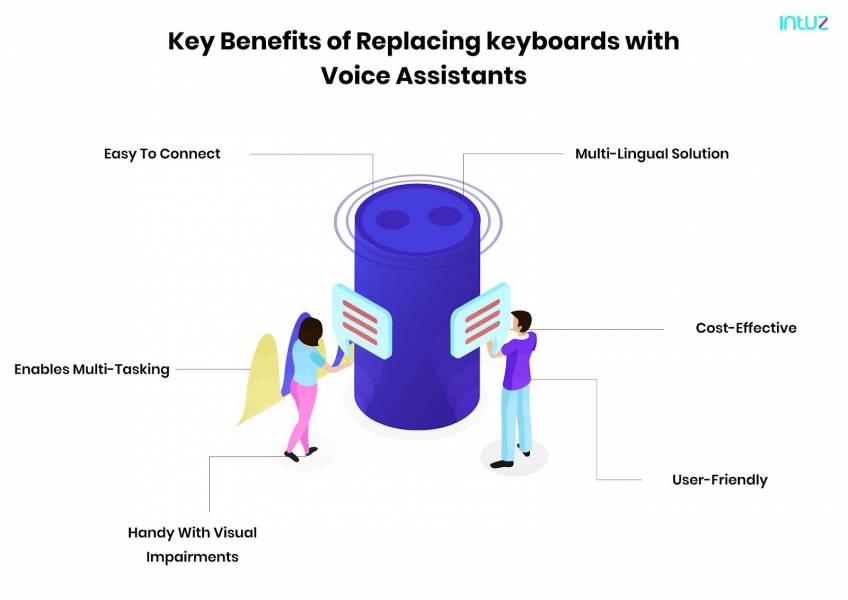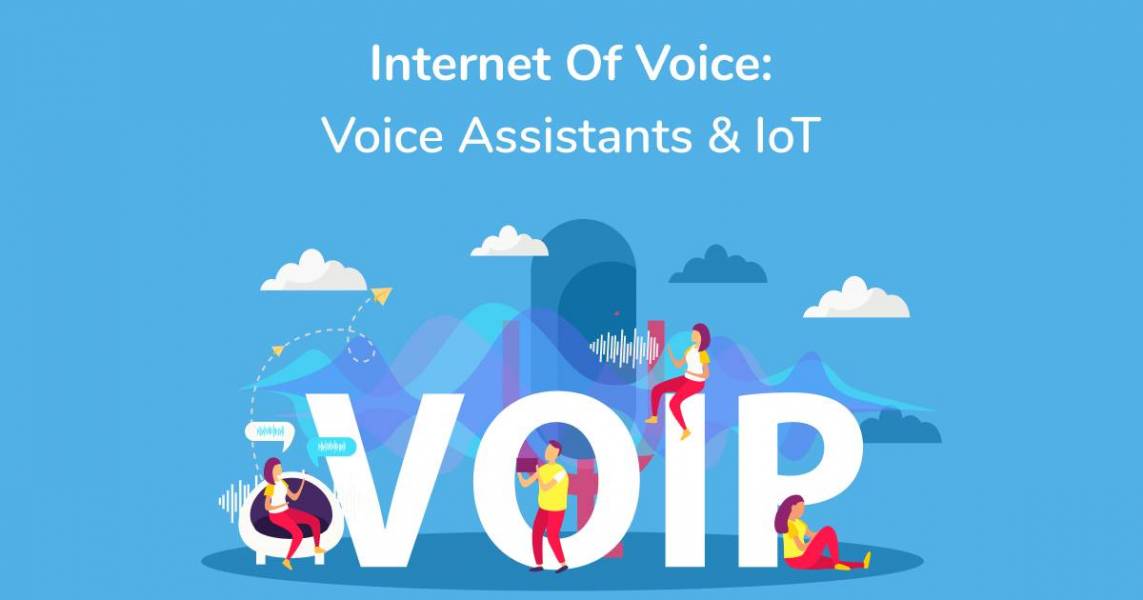If we were to take the word of tech pundits, the Internet of Things is a new-age bubble. IoT devices are essentially rebranded and repackaged Machine-to-Machine products that we’ve always used. After the initial fanatical tech rush and overfunding by capitalists, the frenzy has, eventually, abated. The real technical innovative opportunity – the Internet of Voice – is emerging and is here to stay.
The Internet of Voice answers a basic question – Would you rather type or talk?
It is rather mundane and tedious to key in all our queries into the search. With human society ruled by the power of voice and sound bytes, searching using voice commands comes naturally to us. As we thrive on our ability to articulate our needs, using voice assistance to search and perform other tasks seems more convenient.
What is the Internet of Voice?
Smartphones are the ubiquitous tools we use to stay connected with the digital and physical world. We use the internet for various reasons- to search for information, buy products, or simply play our favorite music. However, with the Internet of Voice, we have the freedom to explore the web using voice commands instead of typing or pressing buttons on smart devices.
Besides using the internet of voice during driving, we can also see its adoption in performing everyday tasks such as controlling lights, operating machines, searching, asking quick queries, and more.
Current Trends and Market Updates
Although we have been slaves to smart devices for a few decades now, it has always seemed mechanical and distant. The Internet of Voice makes up for the lack of human touch by significantly changing how we use our devices to connect with the outside world.
The growth of voice search is so rapid that in 2020, 53 million people owned at least one voice assistant in the US. Since 2018, the number of voice assistants has doubled (reaching 25 million) and this figure is predicted to increase to 275 million by the year 2023. According to Juniper Research, this is a growth rate of 1000% in just 5 years.
How Does the Internet of Voice Work?
The primary issue plaguing internet of things solutions is that these devices first gather data and then apply complex algorithms to extract valuable insights from it. However, it is a round-about way of extracting information.
First, we need to develop devices, identify ways to connect the devices, gather data and then hope to find something meaningful from the data. It essentially needs users to have the technical know-how about installing IoT development services and devices. With the internet of voice, users can simply ask questions and receive immediate, intelligent responses from it.
Given how orally driven our societies are, it is surprising that the voice search hasn’t taken over more significantly. However, Google’s Voice Search and Amazon’s Alexa have been instrumental in changing the market perception and penetration of voice search.
Key Benefits of Replacing keyboards with Voice Assistants
 With voice assistants, we no longer need to pull out our smartphones or press on a button to start – we can simply speak to the internet. Voice search technology was rudimentary until a few years ago; however, the advent of natural language processing, reliable internet, machine learning, and supportive smartphones has enabled the move from keyboards to conversational internet.
With voice assistants, we no longer need to pull out our smartphones or press on a button to start – we can simply speak to the internet. Voice search technology was rudimentary until a few years ago; however, the advent of natural language processing, reliable internet, machine learning, and supportive smartphones has enabled the move from keyboards to conversational internet.
Some of the key benefits of voice search are:
- Since human beings are natural conversationalists, it is easy for us to connect with machines verbally.
- Users can continue to engage with their regular tasks while connecting with their voice assistants.
- Voice assistants come in handy for people with visual impairments.
- Voice assistants can also reduce the overall costs of touch screens and other touch-sensitive smart devices.
- With Google Home and Alexa focusing on improving their offerings in many languages, voice assistants are also becoming a viable option for non-English speaking markets.
- The dependence on keywords to search is gradually reducing, and voice assistants rely on organic language search.
- Along with the internet of things, it is possible to ask your light bulb to kindly turn itself off or request your fridge to order replenishments using your grocery store application.
- Other key benefits are checking the news, playing music, searching for products, asking for directions and sending quick texts or emails.
What’s the Difference Between the Internet of Things and the Internet of Voice?
Although these terms sound vaguely similar, the concepts governing them are quite different from each other. The internet of things refers to a set of interconnected devices that transmit data over the network without requiring human interaction.
On the other hand, the internet of voice makes use of voice and voice commands to acquire information and transfer data over the network.
Smart Devices and Internet of Voice
Smart devices are making technology more interactive and convenient to users. In fact, businesses can easily piggyback on established technologies such as Amazon’s Alexa to build their voice-activated applications. This strategy ensures faster and cost-efficient adoption of voice-activated IoT, as it reduces the need to own high-end technology.
When Google offered Voice search back in 2011, it was merely an innovative feature rather than a staple offering. However, with the improvements in speech recognition technology made over the years, more than half of smartphone users engage with their devices using voice technology. And, 41% of adults use voice search at least once every day.
Smart devices drive the internet of voice adoption globally since new hardware and voice technology software are also shaping up quickly. Improvements in artificial intelligence technology, machine learning, and natural language recognition are making a massive impact on the global mobility of voice search.
All industry trends point out that if voice recognition technology is moving at the current pace, then the future for keyboards looks bleak. Although we are still connected to our smart devices, the mode of engagement is looking to change dramatically. While we might increasingly depend on voice searches for assistance, we could still receive answers displayed on the screen or as a voice response. Regardless of whether you use Apple’s SIRI or Amazon’s Alexa, everyday mundane objects around the house could soon see an upgrade. They could become more interactive and respond to voice commands.
How Voice-over-Internet Protocol (VoIP) Works
 Voice-over-internet protocol or VoIP is the technology that lets you make phone calls using an internet connection. It is cost-effective, comes with a bunch of features and allows you to work from almost anywhere.
Voice-over-internet protocol or VoIP is the technology that lets you make phone calls using an internet connection. It is cost-effective, comes with a bunch of features and allows you to work from almost anywhere.
Computers and other devices make use of the IP address to communicate effectively with each other. Once the telephone is plugged in, it is possible to make calls using a high-speed internet connection. For calls made using VoIP, the information is sent across in the form of small data packets. With the internet, it is possible to send data anywhere in the world within seconds.
VoIP works by connecting your phone to the LAN or Local Area Network. Then, when a telephone number is dialed, your internet-enabled phone lets your VoIP service provider establish a connection with the other number. Once the connection is established, data packets are exchanged between the two phones. The VoIP phone converts the digital signals into the coherent sounds that users hear.
Wrapping Up:
The Internet of Voice technology is disruptive and has the potential to reduce our dependence on smartphones. Since the need to constantly tap or touch the phone to initiate a response is limited, our connection to our smartphones will also see a complete overhaul. The growth of voice recognition technology, innovative IoT development services and hearable devices is pushing us towards a more voice-enabled future.
Contributed by Kamal Rupareliya
Kamal Rupareliya, a Director of Products at Intuz, focusing on innovation through technology such as IoT, JAMStack, and Serverless Computing. He is an expert in IoT, Mobile Design, and Product Strategy, and he loves applying inventive ways to utilize technology and empathy towards creating remarkable digital software products.

Founder Dinis Guarda
IntelligentHQ Your New Business Network.
IntelligentHQ is a Business network and an expert source for finance, capital markets and intelligence for thousands of global business professionals, startups, and companies.
We exist at the point of intersection between technology, social media, finance and innovation.
IntelligentHQ leverages innovation and scale of social digital technology, analytics, news, and distribution to create an unparalleled, full digital medium and social business networks spectrum.
IntelligentHQ is working hard, to become a trusted, and indispensable source of business news and analytics, within financial services and its associated supply chains and ecosystems













